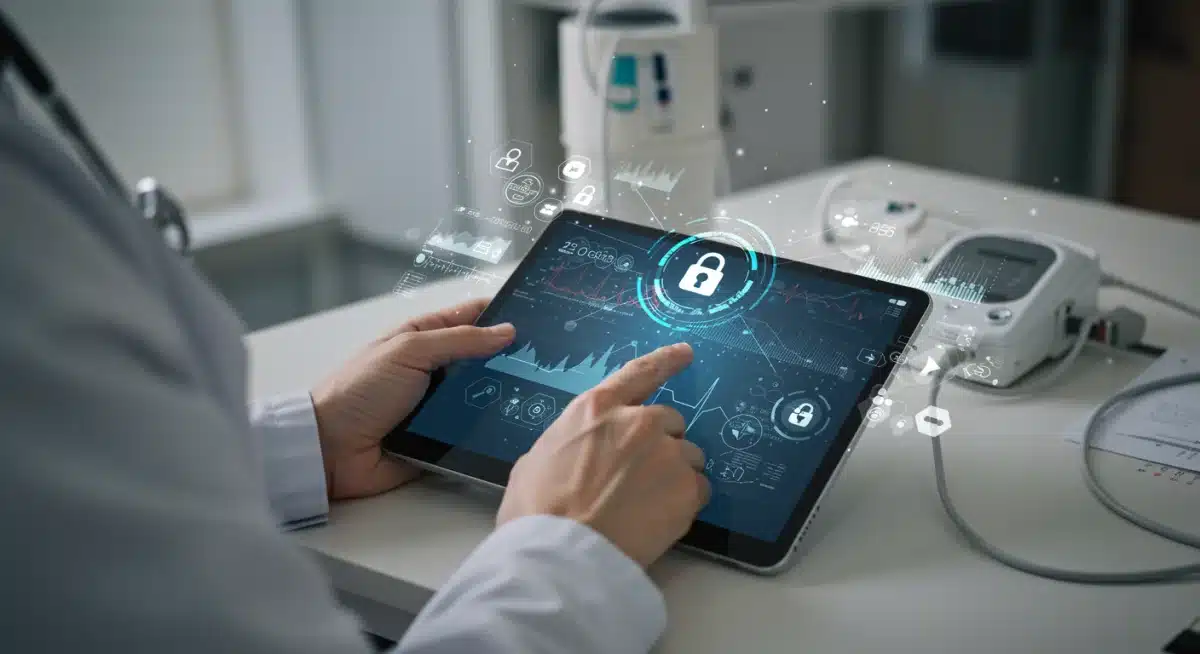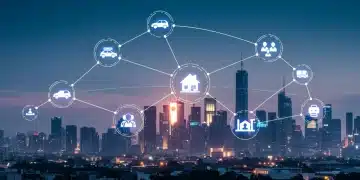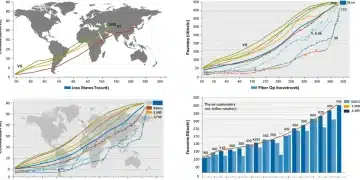5G’s Digital Economy Impact: Unlocking New Business Possibilities

The impact of 5G on the digital economy is profound, unlocking new possibilities for businesses across the United States. This advanced connectivity is driving innovation, transforming industries, and creating unprecedented opportunities for growth and efficiency.
The Impact of 5G on the Digital Economy: Unlocking New Possibilities for Businesses is currently a leading topic, with new developments continually emerging from technology leaders and economic analysts. This article focuses on what 5G means for the American business landscape now, detailing its transformative power and what to expect in the near future.
The Foundation of a New Digital Era: Understanding 5G Connectivity
5G, the fifth generation of cellular technology, is far more than just faster internet. It represents a fundamental shift in how networks operate, offering significantly higher speeds, ultra-low latency, and massive capacity. These core attributes are laying the groundwork for an entirely new digital economy, enabling applications and services that were previously impossible.
The rollout of 5G infrastructure across the United States has accelerated, with major carriers expanding coverage and improving network density. This enhanced connectivity is crucial for businesses looking to leverage advanced technologies such as Artificial Intelligence (AI), the Internet of Things (IoT), and augmented reality (AR) to gain a competitive edge. The robust nature of 5G networks ensures reliable, real-time data exchange, which is paramount for critical business operations and innovative customer experiences.
Key Characteristics of 5G that Drive Economic Change
- Enhanced Mobile Broadband (eMBB): Delivers peak data rates up to 10 Gbps, enabling seamless streaming, faster downloads, and rich content experiences. This directly impacts industries reliant on large data transfers and high-definition media.
- Ultra-Reliable Low-Latency Communications (URLLC): Offers latency as low as 1 millisecond, critical for real-time applications like autonomous vehicles, remote surgery, and industrial automation. This opens doors for entirely new service models and operational efficiencies.
- Massive Machine-Type Communications (mMTC): Supports connections for millions of IoT devices per square kilometer, facilitating widespread sensor deployment for smart cities, smart agriculture, and advanced logistics.
These core capabilities collectively define the transformative potential of 5G. Businesses that understand and strategically implement these features will be at the forefront of the next wave of digital innovation, significantly impacting their operational models and market reach. The ability to process vast amounts of data quickly and reliably is becoming a non-negotiable asset in today’s fast-paced economic environment.
Transforming Industries: How 5G Reshapes Business Models
The transformative power of 5G is not confined to a single sector; it is profoundly reshaping various industries, fostering new business models, and creating unprecedented opportunities. From manufacturing to healthcare, retail to logistics, 5G is enabling a level of connectivity and data processing that fundamentally alters operational efficiencies and service delivery.
In manufacturing, for instance, 5G facilitates the rise of smart factories where machines communicate in real-time, enabling predictive maintenance, enhanced automation, and more agile production lines. This leads to reduced downtime, optimized resource allocation, and higher-quality outputs. The shift towards industry 4.0 is heavily reliant on the robust and low-latency network capabilities that only 5G can provide.
Impact on Key Sectors
- Healthcare: 5G enables advanced telemedicine, remote patient monitoring through connected devices, and even remote-assisted surgeries. The low latency ensures critical data is transmitted instantly, improving diagnostic accuracy and patient outcomes.
- Retail: Enhanced in-store experiences with augmented reality (AR) shopping, personalized promotions, and efficient inventory management through IoT sensors are becoming standard. This creates a more engaging and responsive customer journey.
- Logistics and Transportation: Real-time tracking of goods, autonomous delivery vehicles, and optimized supply chain management are all powered by 5G. This significantly reduces operational costs and improves delivery times, enhancing overall efficiency.
The adoption of 5G is not merely an upgrade but a strategic imperative for businesses aiming to remain competitive and innovative in the rapidly evolving digital landscape. Companies that proactively integrate 5G into their operations are already seeing tangible benefits, from increased productivity to the creation of entirely new revenue streams rooted in enhanced connectivity and data intelligence.
Driving Innovation: New Services and Products Enabled by 5G
The advent of 5G is not just optimizing existing services; it is a catalyst for entirely new innovations, fostering the development of products and services that were once considered futuristic. This next-generation connectivity provides the necessary bandwidth and responsiveness for groundbreaking applications across various domains, fundamentally altering how businesses operate and interact with their customers.
One prominent area of innovation is in immersive technologies. Virtual Reality (VR) and Augmented Reality (AR) applications, which demand immense processing power and ultra-low latency, are now viable for mainstream business and consumer use thanks to 5G. This includes everything from interactive training simulations for employees to immersive customer experiences in retail and tourism. The ability to deliver rich, real-time graphical content without lag transforms user engagement.
Emerging Innovations Powered by 5G
- Enhanced IoT Ecosystems: 5G’s capacity to connect millions of devices simultaneously fuels the expansion of intricate IoT ecosystems. This enables smart infrastructure, advanced environmental monitoring, and comprehensive asset tracking systems that provide unprecedented levels of data and control.
- Edge Computing Integration: By bringing computing closer to the data source, 5G networks reduce latency and improve processing efficiency. This is crucial for applications requiring immediate decision-making, such as autonomous systems and real-time analytics in complex environments.
- AI-Driven Analytics at Scale: The combination of 5G and AI allows businesses to collect, transmit, and analyze vast amounts of data in real-time. This powers predictive analytics, personalized customer experiences, and intelligent automation across all business functions, offering deep insights for strategic decision-making.
The continuous evolution of 5G technology promises to unlock even more possibilities, driving a cycle of innovation that will continue to redefine the digital economy. Businesses that invest in leveraging these new capabilities are positioning themselves not just for present success but for sustained growth and leadership in the future. The landscape of digital products and services is becoming increasingly dynamic, with 5G at its core.
Economic Growth and Job Creation: The Broader Impact of 5G
Beyond individual business transformations, the widespread adoption of 5G is projected to be a significant engine for economic growth and job creation across the United States. Investments in 5G infrastructure, coupled with the development of new applications and services, are stimulating various sectors and creating demand for a skilled workforce. This technological leap is fostering a new wave of economic activity that extends far beyond the telecommunications industry itself.
According to recent economic reports, the deployment and ongoing innovation driven by 5G could add trillions to the global GDP over the next decade. In the U.S., this translates into substantial economic output and millions of new jobs. These jobs span a wide array of fields, from network engineers and cybersecurity specialists to data scientists and developers focused on creating 5G-enabled applications. The demand for expertise in areas like AI, IoT, and edge computing is particularly surging.

Key Economic Contributions of 5G
- Infrastructure Investment: The ongoing build-out of 5G networks requires massive investments in hardware, software, and labor, directly boosting the construction and technology sectors.
- Productivity Gains: Businesses leveraging 5G experience significant increases in efficiency and productivity, leading to higher output and profitability, which in turn fuels further investment and expansion.
- New Market Opportunities: The ability to create novel products and services opens up entirely new market segments, fostering entrepreneurship and attracting venture capital. This diversification strengthens the overall economy.
The long-term economic benefits of 5G are expected to be profound, creating a more competitive and technologically advanced nation. Policymakers and industry leaders are increasingly recognizing the strategic importance of nurturing this ecosystem to ensure sustained economic prosperity and a robust job market for future generations. The full impact of 5G on the digital economy is still unfolding, but its potential for growth is undeniable.
Challenges and Considerations in the 5G Rollout
While the promises of 5G are vast, its widespread deployment and full realization of benefits come with significant challenges and considerations. Addressing these hurdles is crucial for ensuring that the United States can fully capitalize on the transformative potential of this technology. These challenges range from infrastructure deployment complexities to cybersecurity concerns and regulatory frameworks.
One primary challenge lies in the sheer scale of infrastructure required. Deploying dense networks of small cells, especially in urban areas and rural communities, is a complex and costly undertaking. This involves securing permits, managing diverse geographical terrains, and ensuring seamless integration with existing infrastructure. Investment in infrastructure remains a critical component that demands continued collaboration between public and private sectors.
Major Challenges to Overcome
- Infrastructure Density: 5G’s reliance on higher frequency bands often means shorter signal ranges, necessitating a greater density of small cell towers. This is a costly and logistically challenging endeavor, particularly in vast or sparsely populated regions.
- Cybersecurity Risks: With more devices connected and greater data flow, the attack surface for cyber threats expands significantly. Protecting critical infrastructure and sensitive data becomes paramount, requiring robust security protocols and continuous vigilance.
- Regulatory and Policy Frameworks: Harmonizing regulations across different jurisdictions and developing clear policies for spectrum allocation, data privacy, and ethical AI use are essential. Ambiguity can slow down deployment and innovation.
Overcoming these challenges requires a concerted effort from all stakeholders, including government bodies, telecommunications companies, technology developers, and businesses. Proactive planning, strategic investments, and adaptable regulatory approaches are vital to ensuring a smooth and secure transition into the 5G era, maximizing the positive impact of 5G on the digital economy.
The Future Landscape: What to Expect from 5G in the Coming Years
Looking ahead, the future landscape shaped by 5G promises even more profound changes and advancements. As the technology matures and its infrastructure becomes more ubiquitous, we can expect to see an accelerated pace of innovation, deeper integration into daily life, and the emergence of entirely new paradigms for business and society. The current capabilities of 5G are just the beginning of its potential.
One of the most anticipated developments is the full realization of network slicing, a feature of 5G that allows network operators to create multiple virtual networks on a single physical infrastructure. This enables customized network performance tailored to specific applications, such as dedicated slices for critical healthcare services or high-bandwidth slices for entertainment. This level of customization will unlock unprecedented flexibility and efficiency for businesses.

Anticipated Future Developments
- Ubiquitous Connectivity: Expect 5G coverage to become near-universal, including rural areas, bridging the digital divide and enabling equitable access to high-speed internet for all.
- Advanced Edge AI: The combination of 5G and edge computing will facilitate more sophisticated artificial intelligence applications that can process data locally, leading to ultra-fast responses and enhanced privacy.
- Hyper-Personalized Experiences: Businesses will leverage 5G to deliver highly personalized services and products, from customized marketing campaigns to bespoke educational content, driven by real-time data and AI.
The coming years will solidify the impact of 5G on the digital economy, transforming not just how we conduct business but also how we live, work, and interact. Businesses that proactively embrace these evolving capabilities will be best positioned to thrive in this hyper-connected future, continuously adapting and innovating to meet new demands and opportunities.
Key Aspect |
Brief Description > |
|---|---|
Core Capabilities |
Higher speeds, ultra-low latency, and massive device capacity. |
Industry Transformation |
Reshaping manufacturing, healthcare, retail, and logistics through enhanced connectivity. |
Innovation Driver |
Enabling new VR/AR applications, advanced IoT, and AI-driven analytics. |
Economic Impact |
Driving significant GDP growth and job creation across various sectors. |
Frequently Asked Questions About 5G and the Digital Economy
5G offers small businesses affordable access to high-speed internet, enabling cloud-based services, efficient remote work, and enhanced customer engagement through mobile apps. It levels the playing field, allowing them to compete with larger enterprises by leveraging advanced digital tools without extensive infrastructure investments.
While 5G introduces advanced encryption and network slicing for better security, the increased number of connected devices (IoT) expands potential attack surfaces. Businesses must implement robust cybersecurity measures, including endpoint security, network monitoring, and employee training, to protect sensitive data and operations.
Not entirely. 5G and Wi-Fi are complementary technologies. While 5G offers superior mobility and wide-area coverage, Wi-Fi 6 and 7 provide high-speed, cost-effective connectivity for indoor environments. Businesses will likely adopt a hybrid approach, leveraging the strengths of both for optimal performance and flexibility.
5G significantly accelerates AI adoption by providing the necessary bandwidth and low latency for real-time data processing and transmission. This enables AI applications like predictive analytics, machine learning at the edge, and sophisticated automation to operate more efficiently, driving smarter business decisions and operations.
5G enhances remote work by providing stable, high-speed connections, facilitating seamless video conferencing, large file transfers, and access to cloud-based applications. Its reliability reduces latency issues, making virtual collaboration more efficient and productive for distributed teams, regardless of location.
What this means
The ongoing deployment and evolution of 5G are not merely technological upgrades but fundamental shifts that will redefine the digital economy. Businesses must actively monitor these developments, assess their potential applications, and strategically invest in 5G-enabled solutions to remain competitive. The coming years will reveal the full extent of the impact of 5G on the digital economy, solidifying its role as a critical driver of innovation and economic prosperity in the United States.





